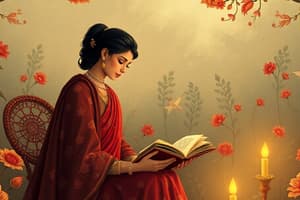Podcast
Questions and Answers
What script is Bengali written in?
What script is Bengali written in?
- Cyrillic script
- Bengali script (correct)
- Devanagari script
- Latin script
Who is a prominent figure in Bengali literature known as a Nobel Laureate?
Who is a prominent figure in Bengali literature known as a Nobel Laureate?
- Jibanananda Das
- Kazi Nazrul Islam
- Rabindranath Tagore (correct)
- Sarat Chandra Chattopadhyay
Which festival is considered the most significant in Bengali culture?
Which festival is considered the most significant in Bengali culture?
- Pohela Boishakh
- Durga Puja (correct)
- Eid
- Baisakhi
What is a staple ingredient in Bengali cuisine?
What is a staple ingredient in Bengali cuisine?
Which body of water borders Bengal to the south?
Which body of water borders Bengal to the south?
What was one significant result of the Partition of Bengal in 1947?
What was one significant result of the Partition of Bengal in 1947?
Which industry has seen rapid growth in Bangladesh?
Which industry has seen rapid growth in Bangladesh?
Which of the following describes the demographics of Bengal?
Which of the following describes the demographics of Bengal?
Flashcards are hidden until you start studying
Study Notes
Language
- Bengali (Bangla) is an Indo-Aryan language.
- Official language of Bangladesh and the Indian state of West Bengal.
- Approx. 230 million native speakers, making it one of the most spoken languages in the world.
- Written in the Bengali script, which is an abugida with its own unique characters.
Literature and Culture
- Rich literary tradition dating back to the 8th century.
- Prominent figures include Rabindranath Tagore (Nobel Laureate), Kazi Nazrul Islam, and Sarat Chandra Chattopadhyay.
- Celebrated for poetry, novels, plays, and short stories.
- The Bengali New Year (Pohela Boishakh) is an important cultural celebration.
History
- Bengal has a rich history influenced by various empires, including the Maurya, Gupta, and Mughal.
- British colonial rule significantly impacted the socio-political landscape of Bengal.
- The Partition of Bengal in 1905 and later in 1947 led to significant demographic and cultural changes.
Cuisine
- Known for its variety of flavors, use of rice, fish, and lentils.
- Signature dishes include Hilsa fish, Bhuna Khichuri, and various sweets like Rasgulla and Sandesh.
- Mustard oil is a common cooking medium.
Festivals
- Major festivals include Durga Puja, Eid, and Pohela Boishakh.
- Durga Puja is the most significant, celebrated with elaborate decorations and rituals.
- Cultural events often feature traditional music, dance, and art.
Geography
- Located in South Asia, bordered by India and Myanmar, with the Bay of Bengal to the south.
- Characterized by the Ganges-Brahmaputra Delta, the world's largest delta region.
Economy
- Agriculture is a significant part of the economy, with rice, jute, and tea as key products.
- Rapid growth in the textile and garment industry, especially in Bangladesh.
Demographics
- Diverse population with various ethnic groups, including Bengali Muslims and Hindus.
- Bengali diaspora is widespread, especially in the UK, USA, and the Middle East.
Notable Contributions
- Contributions to music (Baul, Rabindra Sangeet), art, and cinema.
- Bengali cinema, particularly from Kolkata, has a rich heritage and has produced acclaimed films and directors.
Language
- Bengali (Bangla) belongs to the Indo-Aryan language family and is the official language of Bangladesh and West Bengal, India.
- Approximately 230 million native speakers make it one of the top spoken languages globally.
- It utilizes the Bengali script, an abugida script featuring unique characters for its phonetics.
Literature and Culture
- The Bengali literary tradition has origins dating back to the 8th century, showcasing a rich cultural heritage.
- Notable literary figures include Rabindranath Tagore, the first Asian Nobel Laureate in Literature, Kazi Nazrul Islam, and Sarat Chandra Chattopadhyay.
- Bengali literature encompasses a vast array of genres including poetry, novels, plays, and short stories.
- Pohela Boishakh, the Bengali New Year, is a significant cultural event celebrated with festivities and traditional practices.
History
- Bengal's history is shaped by various empires such as the Maurya, Gupta, and Mughal, each leaving a substantial legacy.
- Under British colonial rule, Bengal experienced profound socio-political changes and disruptions.
- The Partition of Bengal occurred in 1905 and 1947, triggering major demographic shifts and cultural transformations in the region.
Cuisine
- Bengali cuisine is renowned for its diverse range of flavors, prominently featuring rice, fish, and lentils as staples.
- Signature dishes include Hilsa fish, Bhuna Khichuri, and popular sweets like Rasgulla and Sandesh.
- Mustard oil is a prevalent cooking medium, imparting a distinctive flavor to many dishes.
Festivals
- Key festivals in Bengal include Durga Puja, Eid, and Pohela Boishakh, with each celebration carrying unique cultural significance.
- Durga Puja stands out as the most important festival, celebrated with intricate decorations and various rituals.
- Traditional music, dance, and artistic performances are integral to cultural festivities, reflecting the region's vibrant artistic heritage.
Geography
- Situated in South Asia, Bengal is bordered by India and Myanmar, with the Bay of Bengal to its southern coast.
- The Ganges-Brahmaputra Delta, the world's largest delta, characterizes the region's landscape and provides fertile land for agriculture.
Economy
- Agriculture plays a vital role in the economy, with rice, jute, and tea being the main agricultural products.
- The textile and garment industry in Bangladesh is rapidly growing, contributing significantly to the nation’s economy.
Demographics
- The population consists of various ethnic groups, predominantly Bengali Muslims and Hindus.
- A significant Bengali diaspora exists in countries like the UK, USA, and throughout the Middle East, highlighting the global distribution of Bengali culture.
Notable Contributions
- Bengali culture has notable contributions in music, specifically Baul and Rabindra Sangeet, as well as in the arts and cinema.
- Bengali cinema, particularly from Kolkata, boasts a rich heritage and has produced many acclaimed films and renowned directors.
Studying That Suits You
Use AI to generate personalized quizzes and flashcards to suit your learning preferences.



